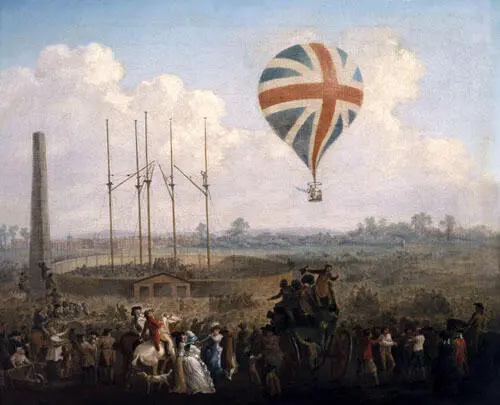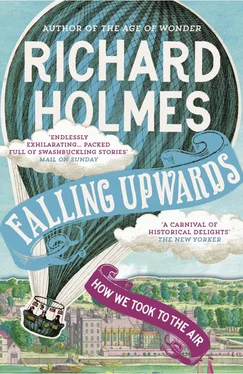Cavallo analysed and dismissed most claims to navigate balloons, except by the use of different air currents at different altitudes. 24He emphasised the aeronaut’s vulnerability to unpredictable atmospheric phenomena such as down-drafts, lightning strikes and ice formation. He deliberately included the first alarming account of a French balloon caught in a thunderstorm, during an ascent from Saint-Cloud in July 1784, and dragged helplessly upwards by a thermal:
Three minutes after ascending, the balloon was lost in the clouds, and the aerial voyagers lost sight of the earth, being involved in dense vapour. Here an unusual agitation of the air, somewhat like a whirlwind, in a moment turned the machine three times from the right to the left. The violent shocks, which they suffered prevented their using any of the means proposed for the direction of the balloon, and they even tore away the silk stuff of which the helm was made. Never, said they, a more dreadful scene presented itself to any eye, than that in which they were involved. An unbounded ocean of shapeless clouds rolled one upon another beneath, and seemed to forbid their return to earth, which was still invisible. The agitation of the balloon became greater every moment … 25

Yet for all this, Cavallo was a passionate balloon enthusiast. He recorded and analysed all the significant flights, both French and English, made from Montgolfier’s first balloon at Annonay in June 1783, to Blanchard and Jeffries’s crossing of the Channel in January 1785. He distinguished carefully between hot-air and hydrogen balloons, and their quite different flight characteristics. He looked in detail at methods of preparing hydrogen gas, noting that Joseph Priestley had come up with one that used steam rather than sulphuric acid. He also examined the different ways of constructing balloon canopies from rubber (‘ cauchou ’), waxed silk, varnished linen and taffeta.
In a longer perspective, he stressed the astonishing speed of aerial travel over the ground – ‘often between 40 and 50 miles per hour’ – combined with its incredible ‘stillness and tranquillity’ in most normal conditions. 26This he thought must eventually revolutionise our fundamental ideas of transport and communications, even if the moment had not yet arrived. But he was less impressed by the horizontal potential of ballooning than by its vertical one. The essence of flight lay in attaining an utterly new dimension: altitude.
He pointed out that in achieving altitudes of over two miles, balloons opened a whole new perspective on mankind’s observations of the earth beneath. Man’s growing impact on the surface of the planet for the first time became visible. As did the vast tracts of the earth – mountains, forests, deserts – yet to be traversed or discovered. Above all he stressed that the full potential of flight had not yet been remotely explored. The situation has perhaps some analogies with the space exploration programme, in the years following the Apollo missions.
Cavallo considered the whole range of possible balloon applications. But he finally and presciently championed its relevance to the infant science of meteorology:
The philosophical uses to which these machines may be subservient are numerous indeed; and it may be sufficient to say, that hardly anything of what passes in the atmosphere is known with precision, and that principally for want of a method of ascending into the atmosphere. The formation of rain, of thunderstorms, of vapours, hail, snow and meteors in general, require to be attentively examined and ascertained.
The action of the barometer, the refraction and temperature of air in various regions, the descent of bodies, the propagation of sound etc are subjects which all require a long series of observations and experiments, the performance of which could never have been properly expected, before the discovery of these machines. We may therefore conclude with a wish that the learned, and the encouragers of useful knowledge, may unanimously concur in endeavouring to promote the subject of aerostation, and to render it useful as possible to mankind. 27
Cavallo’s work was both a challenge and an intellectual landmark in the early history of ballooning. He was largely responsible for the historic first article on ‘Aerostation’, which appeared in the Encyclopaedia Britannica , with notable illustrations, in 1797. This was a signal date. From then on, flight was officially established as a new branch of scientific knowledge, rather than an old backwater of mythology.
Yet there always remains the most enduring early dream or fantasy of flying, which is a metaphysical one. The ultimate purpose is to fly as high as possible, and then look back upon the earth and see mankind for what it really is . This idea has persisted since the beginning, and still continues, sometimes in a satirical form, and sometimes in a visionary one.
The seventeenth-century French dramatist Cyrano de Bergerac (a fearless duellist and also an intellectual provocateur) convincingly reported a secret flight to the moon, undertaken sometime before his death in 1655. It appeared in his posthumously published work Histoire comique des états et empires de la Lune ( Comical History of the States and Empires of the Moon ). Cyrano’s flight is powered by glass cluster balloons, filled with dew and drawn skyward as the droplets are heated by the sun and evaporate: ‘I planted myself in the middle of a great many Glasses full of Dew, tied fast about me, upon which the Sun so violently darted his Rays, that the Heat, which attracted them, as it does the thickest Clouds, carried me up so high, that at length I found myself above the middle Region of the Air. But seeing that Attraction hurried me up with so much rapidity that instead of drawing near the Moon, as I intended, she seem’d to me to be more distant than at my first setting out …’

After an initial power failure and crash-landing, the final approach, made with the additional aid of gunpowder and a lunar force-field, is memorably disorientating: ‘When according to the calculations I had made, I had travelled much more than three-quarters of the way between earth and moon, I suddenly started falling with my feet uppermost, even though I had not performed a somersault … The earth now appeared to me as nothing but a great plate of gold overhead.’
When Cyrano eventually lands, he is captured and cross-questioned by various lunar inhabitants. One, more kindly than the others, remarks: ‘Well, my son, you are finally paying the penalty for all the failings of your Earth world.’ 28Presented before the Lunar Court, he narrowly escapes being condemned to death for impiety. He has maintained the ridiculous notion that ‘our earth was not merely a moon, but also an inhabited world’. He returns in sober mood, crash-landing near a volcano in Italy. 29
Some three hundred years later, on 24 December 1968, the Apollo 8 spacecraft came round from the dark side of the moon. The astronaut Bill Anders later recalled: ‘When I looked up and saw the earth coming up on this very stark, beat-up lunar horizon, an earth that was the only colour that we could see, a very fragile-looking earth, a very delicate-looking earth, I was immediately almost overcome by the thought that here we came all this way to the moon, and yet the most significant thing we’re seeing is our own planet, the earth.’
Читать дальше














